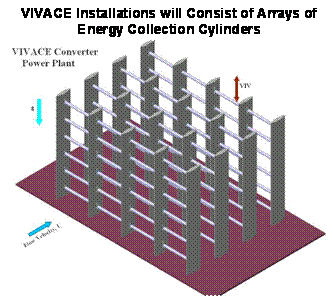VIVACE (Vortex Induced Vibrations Aquatic Clean Energy) is a novel approach to extract energy from flowing water currents. It is unlike any other ocean energy or low-head hydropower concept. VIVACE is based on the extensively studied phenomenon of Vortex Induced Vibrations (VIV), which was first observed 500 years ago by Leonardo DaVinci in the form of “Aeolian Tones.” For decades, engineers have been trying to prevent VIV from damaging offshore equipment and structures. By maximizing and exploiting VIV rather than spoiling and preventing it, VIVACE takes this ‘problem’ and transforms it into a valuable resource for mankind
Vortex Induced Vibrations (VIV) result from vortices forming and shedding on the downstream si de of a bluff body in a current. Vortex shedding alternates from one side to the other, thereby creating a vibration or oscillation. The VIV phenomenon is non-linear, which means it can produce useful energy at high efficiency over a wide range of current speeds.
de of a bluff body in a current. Vortex shedding alternates from one side to the other, thereby creating a vibration or oscillation. The VIV phenomenon is non-linear, which means it can produce useful energy at high efficiency over a wide range of current speeds.
Vortex Induced Vibrations Oscillates Objects in Fluid Currents
VIVACE devices have many potential advantages, which improve installation survivability in the hostile underwater environment and enable low-cost power production by decreasing capital cost and minimizing maintenance.
- High energy density – permits low cost energy to be produced from relatively small installations – requiring up to 50 times less ocean acreage than wave power concepts
- Simple and rugged moving parts – allows for robust designs that can operate for long periods in the underwater environment with minimal maintenance
- Low dependence on ocean/river conditions – application of non-linear resonance permits useful energy to be extracted over a wide range of current speeds
VIVACE and other renewable energy technologies also face regulatory hurdles. Again, VIVACE is advantaged by salient benefits over other technologies.
Non-obtrusiveness – installations can be positioned beneath the surface, thereby avoiding interference with other uses, such as fishing, shipping and tourism
Compatibility with marine life – VIVACE utilizes vortex formation and shedding, which is the same mechanism fish use to propel themselves through the water
prototype, funded by the U.S. Department of Energy and the Office Naval Research, is currently operating in the Marine Hydrodynamics Laboratory at the University of Michigan. This device has met and often exceeded expectations; thereby, providing strong evidence to proceed to the next scale, a multi-kilowatt field demonstration.

